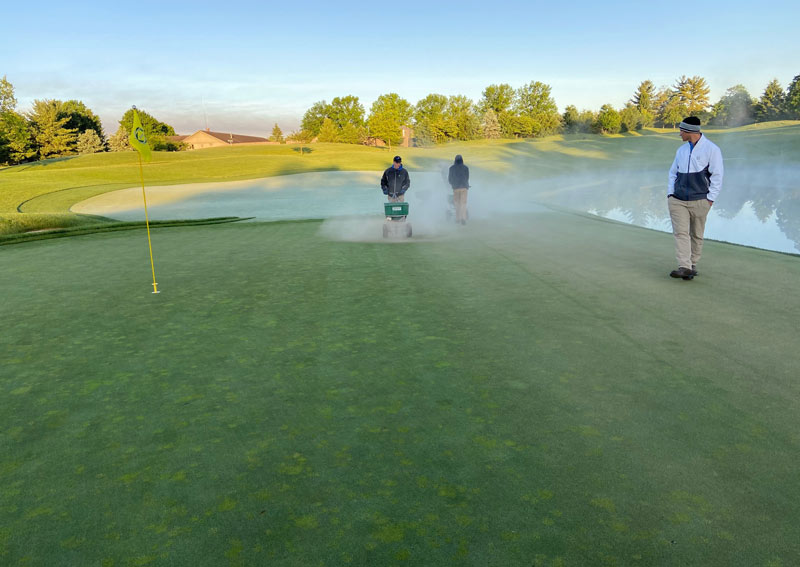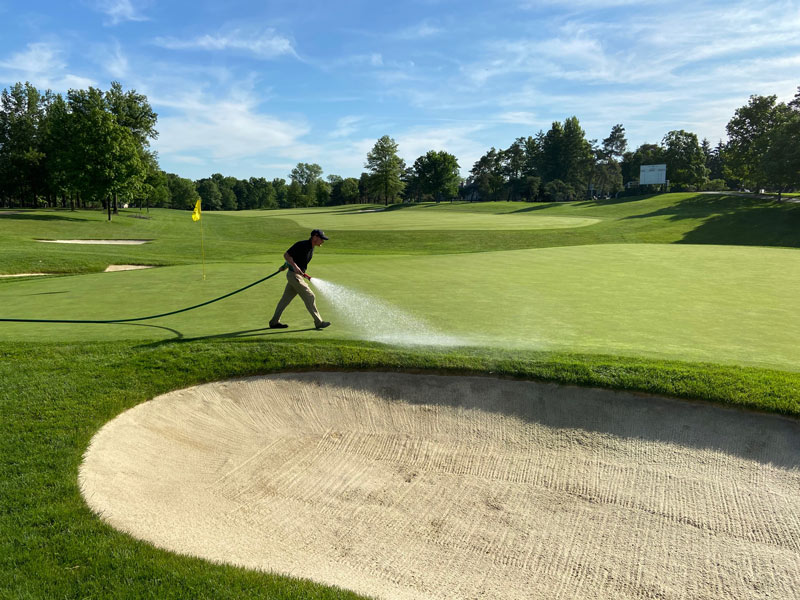Update: On Monday, July 6, organizers of the Memorial Tournament at Muirfield Village Golf Club announced the event will be held without fans on-site, a change from previous plans.

Muirfield Village Golf Club assistant superintendent James Bryson (right) looks on as crew members topdress on June 1, the original day Memorial Tournament week had been set to kick off at the club, located just outside Columbus, Ohio. Photo courtesy of Chad Mark
Normally, the thought of preparing one golf course to host two consecutive PGA Tour events in consecutive weeks would have given Chad Mark pause.
“Any other year,” says Mark, GCSAA Class A superintendent and director of grounds at Muirfield Village Golf Club, “I’m not sure we could do it.”
Of course, 2020 isn’t just any year, and until now, there wasn’t any reason to even entertain such a notion. But cancellations and concessions coalesced just so, and over two weeks in July, Muirfield Village will be the site of a PGA Tour doubleheader — the Workday Charity Open, July 9-12, and the Memorial Tournament presented by Nationwide, July 16-19 — an unprecedented occurrence in the modern era of the PGA Tour.
Those same weeks, TPC San Antonio will host its own unprecedented tour twin bill, albeit on a slightly smaller scale and different stage — or stages. The Korn Ferry Tour will be hosting consecutive events at TPC San Antonio: the TPC San Antonio Challenge at the Canyons Course, July 6-12, and the TPC San Antonio Championship at the Oaks Course, July 13-18. As the names suggest, although the events will be played at the same complex, they’ll be contested on different courses, which brings about its own set of challenges.
“We’re excited to see how it goes,” says Roby Robertson, CGCS, TPC San Antonio’s director of golf course maintenance operations. “There’s no road map for something like this. There will be hiccups and hurdles, but every hiccup and hurdle is an opportunity to learn. And when we’re done, then we’ll have a road map at that point.”
Memorial and more at Muirfield
Muirfield Village, just outside Columbus, Ohio, has hosted the Memorial since 1976. Never before, though, has the staff there experienced the event being postponed from its usual late May/early June slot — this year’s event was originally scheduled June 4-7 — into the heat of summer, plus the added bonus of putting on another PGA Tour event the week prior.
“It’s been a wild ride,” says Mark, a 23-year GCSAA member. “It’s been craziness inside of this crazy world we live in now with COVID. In some ways, it’s not really sunk in yet.”
(There were 11 instances of PGA Tour twin bills from 1948-1957. In all but one, the All American Open was followed by the World Championship of Golf in August at Tam O’Shanter Golf Course in Niles, Ill.)
The challenge Mark and his staff at Muirfield have faced is twofold. First, they had to shift agronomic gears to prepare for a tournament peak that will occur weeks later than initially anticipated. Then there’s the whole two-tournaments-in-two-weeks thing.
“In Columbus, Ohio, the weeks of those tournaments are the toughest of the year,” Mark says. “Mid-July is the peak of summer heat and humidity. The end of May is both a blessing and curse. It’s a blessing because of the cooler nighttime temperatures, and you don’t have the heat stress or as much mechanical damage, but you only have a few weeks to prepare the golf course. We’ll have more time to lead into this July date, but we will have some heat stress heading into the tournament.”
Typically, Mark says, the plan is to have Muirfield Village — the “course that Jack built,” as it’s called, a nod to its architect/visionary/hometown hero Jack Nicklaus — in top form for the earlier-season Memorial, aerate the following week, and then baby it back to health. “We open it back up for member play,” Mark says, “and it’s usually good by July 4. We haven’t seen this golf course go through that peak aeration in early July. We’re feeling some things out. We had to shift some agronomic programs. But we saw it coming and were able to change some things.”
Muirfield Village staffers were among the essential workers who toiled through March, though the club remained closed through April. When it appeared that the Memorial would be bumped or even canceled, the club started some minor work on a planned renovation. When the event was officially postponed, the renovation worked picked up, primarily in the form of some new fairway bunkers.
“In the midst of that, we were approached about, ‘What about doing back-to-back weeks?’” Mark recalls. “My initial thought was, it (the additional event) would be held after the Memorial, and that would delay the renovation. I thought, ‘Holy cow. We’ve got a lot to do.’”
As it turns out, that renovation is one of the things that could make this twofer doable. Immediately after the Memorial (which is the week after the Workday Charity Open), the course will close for the renovation to get underway in earnest.
“Early on, they came to me and wanted to know if the golf course could take it,” Mark says, “before we went to Jack with it. Any other year, I’m not sure we could do it. But we’re closing the course the week after the Memorial ends. Given that circumstance, the golf course ... if we do it right the first week and not peak too early, yes, we can do it.”
Mark says his biggest concern is his people.
“I’m just as worried about my staff as the golf course,” he says. “Asking people to get up at 3 in the morning for two weeks ... that’s the hard part. You’ve got to make sure everybody gets some breaks. We’re grinding, but morale is still good so far.”
Mark says he’s working 20 “turf guys” on a rotation, with 10 days on and two off. “The rest of the staff gets off every other weekend,” he says. “We’re still sticking to that. If you don’t, the guys will start dragging pretty good. And we start a renovation the day after the tournament ends, so it doesn’t get any easier after that. It’s important to keep ’em fresh. If we catch a rain day here or there, we get the guys out of here.”

Seamus Foley, a second assistant at Muirfield Village Golf Club, hand-waters the seventh green on June 18. Photo courtesy of Chad Mark
Mark lauded the work and crew management done by assistants James Bryson and Adam Daroczy, both of whom are four-year GCSAA members. They’ve all had to adapt to the notion of making do with fewer volunteers than in years past. Mark says he usually taps a volunteer workforce that numbers in the 40s; he anticipates between 20 and 22 for this year’s Memorial, and maybe only a handful for the Workday Charity Open, those declines attributable to coronavirus.
“That’s definitely changed a lot of what we’re doing,” he says. “We’ve had to adapt, but the staff has done a great job with that.”
The Workday event was created to fill a void left by the cancellation of the John Deere Classic amid coronavirus worries, and it plays into the Tour’s “bubble” approach of keeping players and workers as insulated as possible. One particular hurdle the Muirfield staff faces is having to prepare a course that provides a different challenge in consecutive weeks. To that end, Mark, who has been at Muirfield since 2017, is glad the Memorial — which is known for its tricky long roughs and speedy greens — is the second of the two events.
“If you have to do this, it’s a lot easier to have a steady climb to a peak than it is to be at the peak and then have to deal with the next tournament,” he says. “Whether it’s a different set of expectations or not, it’s easier to rise to a peak than to turn it up and then dial back.”
The Workday Charity Open will boast a full field of 156 golfers — and no fans. The Memorial, a special invitational on the PGA Tour, will have a field of 120 and is slated to be the first event of the restarted season that will allow fans on course. The gallery is expected to be limited to about 8,000 fans, or 20% of Muirfield’s capacity, to adhere to state social-distancing guidelines.
Editor’s note: Read about how the team at Colonial Country Club in Fort Worth, Texas, prepped to pull off the 2020 Charles Schwab Challenge, the event that marked the return of pro golf in the age of coronavirus.
Mark isn’t sure how apparent the course’s setup differences will be to casual viewers. “When you’re here, it will be obvious,” Mark says, “but I don’t know how much the average fan will notice. There are a lot of people who are shocked to learn you change holes every day. I hope people don’t think there’s a night-and-day difference. We want it to be a great test both weeks.”
That’s where Mark’s mantra about Muirfield comes in handy. “We do try to have championship conditions on a daily basis here at Muirfield,” he says, “so the guys are already in tune to that pressure. We feel we can take this on.
“Many of them are super excited. There’s this element of confidence, just the test of no one has done this — two PGA Tour events back to back. They’re all excited about it. We’ve got a lot of guys we bring in to intern. When I told the staff, their eyes lit up. The guys who worked the past three Memorials with me, they got the look on their faces, ‘Wow. That will be a lot of work.’ They know getting there is the hard part. When you get to tournament week and you get a few volunteers to help out, that’s the easier part.”
Deep in the heart(ache) of Texas
Some 1,300 miles southwest, Robertson and the crew at TPC San Antonio are facing a similar but markedly different challenge. While he doesn’t have to worry about the increased scrutiny that comes with appearing on live television, or the wear and tear of a tournament twofer on the same 18 holes, Robertson is still keeping plenty busy juggling a staff tasked with prepping not one but two courses for professional golf.
“You can’t just concentrate all your staff on one side, like when you’re getting ready for a tournament on one golf course,” says Robertson, a 33-year GCSAA member. “You have to prepare both at the same time while still being open for member play. You focus most of your manpower on the one golf course having the tournament that week, and it’s advance week on the other golf course. Our guys will get plenty of overtime, that’s for sure.”
Like the Muirfield double feature, the Korn Ferry Tour twin bill at TPC San Antonio was made possible by a PGA Tour cancellation. Sort of. TPC San Antonio’s Oaks Course was scheduled to host the PGA Tour’s Valero Texas Open April 2-5, but that event was canceled because of the pandemic.
“We were two weeks out from the Valero,” Robertson says. “All the stands were up. We were ready to go. Then — canceled.”


TPC San Antonio crew members at work ahead of last year’s Valero Texas Open, contested April 4-7 on the Oaks Course. Photos courtesy of TPC San Antonio
The team adjusted. With the facility closed for golf because of the pandemic, Robertson and his staff moved up the courses’ agronomic plans.
“We had started preparing the golf courses for summertime play,” he says. “When we heard we were being considered for a twofer, back to back, we said, ‘All right. Let’s go.’ Both courses are in really great shape. The best part of this is, we’re doing it without a lot of volunteers. This year, with the travel situation, we’re a little short of normal from what we’d normally have for such an event, but the thing about being a TPC facility is, there aren’t too many of us who could not put the place together for something like this.”
Robertson says the Korn Ferry doubleheader takes some of the sting out of having the Valero Texas Open called off.
“There was a little heartache when it was canceled so close to the event,” he says. “The guys get so excited. With the big show on television, they’re ready to see the course shine. So they were a little let down. But once we saw we were open for this opportunity, ‘Hey, guys, we’re back on the schedule.’ Even though it won’t be a televised event, they’re excited to do it.”
Robertson says his biggest concern is keeping his staff safe. Motivation, he maintains, won’t be an issue. Among the perks: swollen paychecks, tournament shirts, twice-a-day feedings from a rotation of food trucks, and the opportunity to pull off a Korn Ferry Tour — and TPC network — first.
“Over three weeks, you get into a rhythm,” Robertson says. “I wouldn’t say there’s burnout. But it’s July — it’s hot and muggy. I wouldn’t say burnout, but it’s exhaustion. Mother Nature is usually the biggest unknown. My biggest concern is probably the weather. If it gets really hot and humid, it’s not just the workers and the team. Those two golf courses there can be a pretty good walk, so keeping everybody hydrated is a big concern. We’ll make sure everybody is hydrated and the course is too. There’ll be a lot of hand watering those days.”
Echoes of Pinehurst
Though big-time professional golf tours do not, in normal years, hold consecutive events at the same venue over consecutive weeks, there is a precedent for a top-tier twofer. Back in 2014, Pinehurst played host to consecutive U.S. Opens — first the men, then the women — on its storied No. 2 course in consecutive weeks. That was the first time two golf majors had been played at the same site in back-to-back weeks.
“I was listening to PGA Tour Radio, and they were talking about Muirfield,” says Bob Farren, CGCS, Pinehurst’s director of golf course maintenance and a 39-year GCSAA member. “It did trigger some thoughts, some memories of what we did, though it is kind of flipped for them from what we did, since we had the men first and then the women.”
Farren recalls there were external concerns going in that the golf course would be a bit battered by the time the women teed off.
“There were some criticisms that there would be too many divots for the women to contend with,” he says, “but that was not the case at all. They played from some different areas than the men, so that wasn’t a problem.”
Like Robertson at TPC San Antonio, Farren was most concerned about weather complications.
“We only had one storm,” he says. “Seldom can we go two weeks in the sandhills and not have pop-up storms in the evening, but (in 2014) we only had one. It came in really fast, and there was some damage, but we dealt with it. Now, if they get storms at Muirfield, that’s where you really need to have some contingencies.”
Among the factors over which he had control, Farren says he paid particular attention to morale and the need to manage the many volunteers necessary to put on an event as labor-intensive as a major.
“From a management prospective,” he says, “those were the key pieces, as far as I was concerned. How do you maintain that level of energy for two weeks, instead of just one? How do you not burn yourself out the first week and not be a zombie the second week? You’re almost a zombie by round four of a normal championship, and you have to turn around and do it again the next week. We consciously made ourselves understand that — the whole leadership team.”

The Canyons Course at TPC San Antonio, which will welcome the TPC San Antonio Challenge July 6-12. The spotlight will shift to the facility’s Oaks Course just one day later for the TPC San Antonio Championship, July 13-18. Photo courtesy of TPC San Antonio
The volunteer piece was mostly a matter of logistics — and one that was aided by the fact that Pinehurst is a nine-course complex with lots of bodies available. Farren and his staff made sure all of those bodies understood the novelty of the moment and, importantly, took time to savor it.
“We approached it with the sense of, it will be the best one ever, because it’s the only one, and it had never been done before,” Farren says with a laugh. “But in hindsight, there’s not any one single thing we would have done differently or any one thing we would have prepared for differently. It all went very smoothly.
“Psychologically, you have to prepare for it to be a marathon. It’s not a sprint. You have to find ways every day to enjoy it, to enjoy the fact you’re doing it. You have to be intentional about that every single day. I told a number of our guys over that time, at some point, to stop and intentionally soak it in — to hear the sounds and smell the smells and enjoy all the things that go with it, because those are the things you remember.
“Regardless,” Farren continues, “you get pretty exhausted. It’s a big footprint of labor. But I wish them the best of luck.”
Andrew Hartsock is GCM’s managing editor.